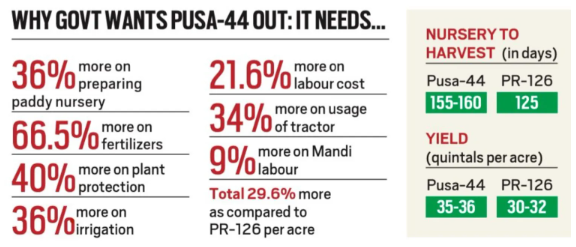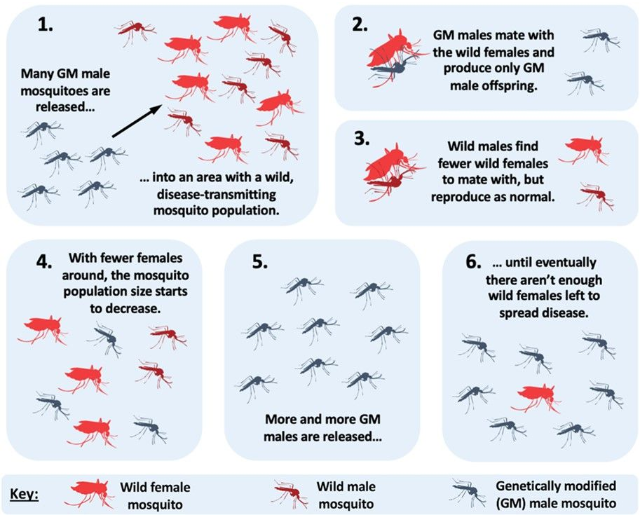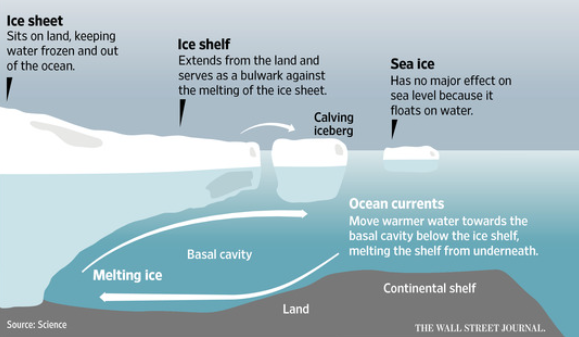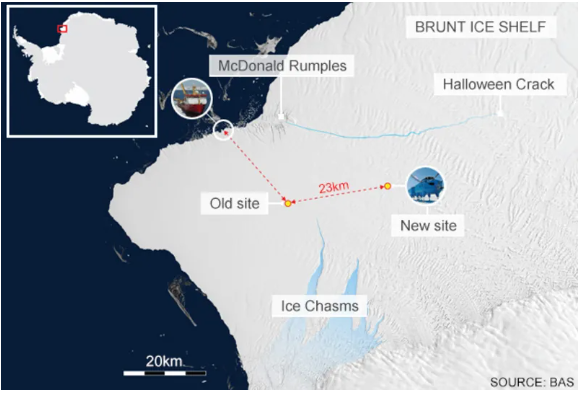PUSA-44
Many challenges are associated in the curbing cultivation of a banned rice variety in Punjab.
- PUSA-44 – A paddy variety developed in 1993, by the Indian Council for Agricultural Research (ICAR).
Punjab government banned PUSA-44 in 2023 while varieties like Peeli PUSA and Dogar PUSA were discouraged.
- Concerns – It takes longer to grow and requires more water thus requiring 5 to 6 extra cycles of irrigation.
- Moreover, this variety is also known to exacerbate the issue of stubble burning in the state which greatly contributes to winter pollution in northern India.

The straw stubble or residue of the rice crop planted in the kharif season (from July to October) is left in the fields as the winter crops (for the Rabi season from November to March) are set to be planted.
- Benefits of banning – It had reportedly saved 5 billion cusecs of water & saved Rs. 477 crores through reduced power consumption.
- Challenges – It is still used owing to higher yield of around 32 to 36 quintals per acre and thus ensuring higher incomes.
- Measures – Punjab government is promoting PR-126 variety.
- Despite its lower yield, its overall expenditure is lower than PUSA-44.
References
- The Indian Express| Challenges in curbing PUSA-44 cultivation
- The Indian Express| Reason for banning PUSA-44
Rivers of lava on Venus
A new analysis of data from Magellan spacecraft finds signs of fresh lava flows occurring on the Venusian surface between 1990 and 1992.
|
Venus
|
- It is the 2nd planet from the Sun, and the 6th largest planet.
- It is the hottest planet in our solar system.
- Twin sister – It is similar in size to Earth.
- Long days – Its day is longer than its year.
- Features – It has volcanic plains and rifts.
- Runaway Greenhouse – Its thick atmosphere traps heat.
- Foul clouds – Its sulphuric acid clouds smell like rotten eggs.
- Science hotspot – More than 40 spacecraft have visited.
- Backward sunrise – The Sun rises in the west & sets in the East.
|
- Rivers of lava - 2 vast, sinuous lava flows oozing from 2 different corners of Venus.
- Sif Mons – It has a large shield volcano on its western slopes.
- Niobe Planitia – A flat region studded with volcanic vents.
- Volcanic eruptions tinker with planetary atmospheres and thus creating opaque clouds.
- Causes – Venus lacks the plate tectonics of Earth but its similarly rocky constitution and comparable size suggests that something must still be cooking inside and it should be volcanically active.
- Indirect evidence – Volcanic gases linger in Venus’ skies, and the planet glow suggests lava flows in the recent geologic past.
- Direct evidence – In 2023, researchers found a volcanic vent doubling in size & possibly filling with lava in old Magellan data.
Magellan
Magellan was the 1st spacecraft to image the entire surface of Venus and the 1st deep space probe launched by a space shuttle.
- Aim – To image the entire surface of Venus.
- Launched by – NASA, in 1989.
- It used cloud-penetrating radar to survey most of the planet.
- Findings – At least 85% of the surface is covered with volcanic flows.
- Despite the high surface temperatures (475 degrees Celsius) and high atmospheric pressures (92 atmospheres), the complete lack of water makes erosion an extremely slow process on the planet.
NASA’s DAVINCI and VERITAS probes, expected to launch next decade, will map the Venusian surface in far more detail manner.
References
- The Indian Express| Rivers of lava in Venus
- NASA| Features of Venus
Dag Hammarskjöld Medal
Indian peacekeeper to be honoured posthumously with prestigious United Nation (UN) medal for sacrifice in line of duty.
- It is a posthumous award given annually on the International Day of United Nations Peacekeepers.
The International Day of UN Peacekeepers, marked on May 29, was established by the UNGA in 2002, to pay tribute to all men and women serving in peacekeeping, and to honour the memory of those who have lost their lives in the cause of peace.
- Honoured by – UN, at its Headquarters in New York.
- Established in – 1997, by UNSC resolution 1121.
- Beneficiary – Members of military, police, and civilian peacekeepers, who lost their lives serving under the UN flag.
- The Under-Secretary-General for Field Support also accepts a medal on behalf of deceased civilian staff each year.
In 1998, the 1st Medal was presented to the family of Dag Hammarskjöld. The 2nd medal honoured Commandant René de Labarrière, who was the 1st peacekeeper to lose his life in a UN peacekeeping operation, in 1948.
- 2024 award – It pays tribute to the more than 76,000 UN peacekeepers who embody humanity’s highest ideal: peace.
- From India – Naik Dhananjay Kumar Singh, who served with the UN Stabilisation Mission in the Democratic Republic of Congo (MONUSCO).
- Previously, 3 Indian peacekeepers were honoured in 2023.
|
Other UN Medals
|
- Captain Mbaye Diagne Medal – It was launched in 2014 by UNSC, to award those military, police, civilian UN personnel and associated personnel who demonstrate exceptional courage, in the face of extreme danger, while fulfilling the mandate of their missions or their functions, in the service of humanity and the UN.
- UN Military Gender Advocate of the Year Award – It was started in 2016, to recognise the dedication and effort of an individual peacekeeper in promoting the principles within the UNSC Resolution 1325.
|
UNSC Resolution 1325 urges all actors to increase the participation of women and incorporate gender perspectives in all UN’s peace and security efforts.
Quick Facts
- United Nations Truce Supervision Organisation – It was started in 1948, when UN deployed military observers to the Middle East to supervise the Israel-Arab Armistice Agreements execution.
- UN Peacekeeping operations – India is the 2nd largest contributor of uniformed personnel to UN Peacekeeping.
- Nearly 180 Indian peacekeepers have made the supreme sacrifice in the line of duty, the highest number by far from any troop-contributing country.
References
- The Hindu| Indian to receive Dag Hammarskjold Medal in 2024
- UN| United Nation Medals
GM Mosquitoes
Djibouti releases GM mosquitoes to fight malaria as part of a pilot project.
This is the 1st time a GM mosquito has been released in East Africa and the 2nd time on the African continent. Burkina Faso in West Africa conducted the 1st ever release of GM mosquitoes in Africa.
- Umbrella Programme – Djibouti Friendly Mosquito Programme, that aims to stop the spread of Anopheles stephensi.
|
Anopheles stephensi
|
- It is an invasive species of mosquito.
- It was detected 1st detected in Africa in 2012 with 27 reported cases in Djibouti.
- Invasiveness – They had migrated to Africa from South Asia and the Arabian Peninsula.
- Urban spread - Unlike other malaria-carrying mosquitoes in Africa that primarily breed in rural areas, these are well adapted to the urban environment.
|
- Production – They are produced using a technique called embryonic microinjection.
- An engineered DNA often called a transgene when injected in mosquito eggs integrates into the mosquito genome and specifically activates or inactivates a target gene.
- GM mosquitoes are made to carry 2 types of genes
- A self-limiting gene – It prevents female mosquito offspring from surviving to adulthood.
- A fluorescent marker gene – It glows under a special red light, allowing the researchers to identify them in the wild.
- Control method – It targets female mosquitoes, as male mosquitoes do not bite and therefore cannot transmit malaria.
- This method targets only the particular species of mosquitoes which was genetically modified, here it is Anopheles stephensi.

GM mosquitoes have been successfully used in parts of Brazil, the Cayman Islands, Panama, and India to control Aedes aegypti mosquitoes. Since 2019, over 1 billion mosquitoes have been released.
References
- Down To Earth| GM Anopheles stephensi Mosquitoes in Djibouti
- CDC| GM Mosquitoes
Ice Calving & Halloween Crack
A large iceberg A83, measuring 375 square kilometres, broke off from Antarctica’s Brunt Ice Shelf last week in a major ice calving event.
- Ice Calving – A process whereby intact chunks of ice are discharged to the oceans from the termini of glaciers or ice shelves.
Ice shelves are floating ice platforms connected to a landmass, found in Polar Regions like Antarctica and Greenland.

- Occurrences – Over a huge range of time & length scales on glaciers around the world.
- Rate of calving – It often change annually, with calving slowing or shutting down entirely over the winter.
- Determining factors – Melting of the glacier surface, undercutting of the calving face by warm fjord water or the resistance from sea ice in fjords and amount of sea ice.
- When less sea ice is present, ice shelves are more exposed to destabilising wind and wave action.
- Impact – It leads to mass loss for the world’s ice sheets.
- It is important in the stability of marine-terminating glaciers, with an initial calving retreat potentially able to destabilise the grounding line and trigger acceleration of the glacier.
The Halloween Crack
- It is a rift which was 1st spotted off the Brunt Ice Shelf in the eastern Weddell Sea in the Antarctica.
- The iceberg is named as Iceberg A-83
- It runs from an area known as McDonald Ice Rumples, which is where the underside of the floating ice sheet is grounded on the shallow seabed.
- This pinning point slows the flow of ice and fractures the ice surface.

References
- The Indian Express| Iceberg emerges from the Halloween Crack
- Antarctic Glaciers| Ice Calving



